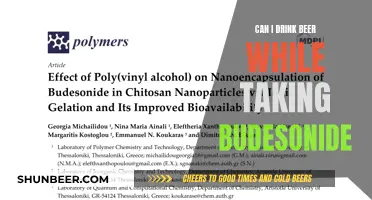
Scotland has a reputation for heavy drinking, with beer being produced in the country for over 5,000 years. However, recent surveys suggest that attitudes towards alcohol in Scotland are changing, with a decrease in hazardous or harmful drinking over time. The Scottish Health Survey 2022 reported that the prevalence of hazardous or harmful drinking dropped from 34% in 2003 to 22% in 2022, with a corresponding increase in the proportion of non-drinkers. While alcohol consumption in Scotland is similar to that in England, with both countries having a significant proportion of adults drinking within official guidelines, there are concerns about the impact of alcohol on public health in Scotland. Alcohol-related deaths and hospital admissions have been on the rise, and efforts are being made to address this issue.
What You'll Learn

Alcohol consumption in Scotland
The Scottish government has recognised the detrimental impact of alcohol on individuals, families, communities, and the nation. In 2018, Scotland became the first country to impose minimum prices on alcoholic beverages. This measure aimed to reduce excessive drinking, particularly among those who tend to purchase cheaper drinks and multipack deals. The law sets a minimum price per "unit", which is equivalent to 10 millilitres of pure alcohol, with the rate expected to be 50 pence per unit. While this has been a controversial move, it reflects the seriousness of the issue and the need to address Scotland's relationship with alcohol.
According to the Scottish Health Survey 2022, there has been a general decrease in hazardous or harmful drinking over time, with levels dropping from 34% in 2003 to 22% in 2022. This decrease was accompanied by an increase in the proportion of adults classified as non-drinkers, rising from 11% in 2003 to 19% in 2022. However, men were found to be significantly more likely than women to drink at hazardous or harmful levels across all age groups. The average number of alcohol units consumed per week by all drinkers in 2022 was 12.6 units, with a significant variation by age, ranging from 15.5 units among 16-24-year-olds to 10.2 units among those aged 75 and above.
While the overall alcohol consumption in Scotland and England is similar, with both countries having more than three in five adults drinking within official guidelines, there are some differences in drinking cultures. In Scotland, there is a perception that getting drunk is more socially acceptable, with 19% of Scots considering it acceptable to get drunk on weekends, compared to a lower proportion in England. Additionally, younger people in Scotland were less likely to be teetotal, with 16% of under-25s not drinking alcohol, compared to 24% in England. This suggests that while overall consumption may be comparable, the drinking patterns and attitudes towards alcohol differ between the two nations.
Beer Consumption: Blindness Risk and Visual Health
You may want to see also

Scots' attitudes towards alcohol
Scotland has long been associated with heavy drinking, but Scots' attitudes towards alcohol are changing. While the stereotype of Scots as heavy drinkers persists, the Scottish public is becoming increasingly aware of the social problems caused by alcohol.
According to the Scottish Social Attitudes (SSA) survey of 2013, only 19% of Scots believe that getting drunk on weekends is acceptable. This figure has not changed much in a decade, but the number of young people holding this view has dropped sharply, from 53% in 2004 to 40% in 2013. Similarly, just 16% of Scots agree that getting drunk is part of being Scottish, with 62% disagreeing. These responses indicate a shift in attitudes, as most Scots do not approve of excessive drinking and reject the notion that it is intrinsic to Scottish culture.
Despite these changing attitudes, many Scots still drink excessively. The Scottish Health Survey reveals that 41% of Scots drink more than the recommended guidelines, and hazardous or harmful drinking levels range from 15% in those aged 75 and over to 28% in the 55-64 age group. Men are more likely to drink at hazardous levels than women across all age groups, with the highest proportions among those aged 55-64 and 16-24.
The average number of alcohol units consumed per week by all drinkers in Scotland was 12.6 units in 2022, with significant variation by age, from 15.5 units among 16-24-year-olds to 10.2 units for those aged 75 and older. The prevalence of hazardous drinking is higher in less deprived areas, with 28% in the least deprived quintile compared to 19-23% elsewhere.
While Scots' perceptions of alcohol are evolving, there are still challenges in fostering more positive attitudes. Some drinkers believe that others will find it odd if they don't drink at all, and there is a lack of clarity about what constitutes sensible drinking and the number of units in alcoholic drinks. These findings highlight the need for continued efforts to increase awareness and promote healthier relationships with alcohol in Scotland.
Beer and Gastric Patients: What's Safe to Drink?
You may want to see also

Alcohol-related harm
The Scottish Health Survey 2022 reports that the average number of alcohol units consumed per week by drinkers was 12.6 units, with a significant variation by age: 15.5 units for those aged 16-24 and 10.2 units for those aged 75 and over. Hazardous drinking levels also varied by age, with 15% of those aged 75 and over and 28% of those aged 55-64 drinking at hazardous levels. Men were significantly more likely than women to drink at hazardous levels across all age groups, with 37% of men aged 55-64 and 37% of men aged 16-24 drinking hazardously.
Alcohol misuse has substantial health, social, and economic impacts. Health-wise, alcohol consumption is associated with an increased risk of developing liver diseases, heart diseases, and various types of cancer. It also contributes to mental health issues such as depression and anxiety. Worldwide, alcohol is responsible for millions of deaths annually, with 2.6 million alcohol-attributable deaths in 2019. Alcohol misuse is also a causal factor in more than 200 diseases and injury conditions, including cirrhosis, inflammation of the gut and pancreas, heart and circulatory problems, and eye disease. It also increases the overall risk of mouth, throat, oesophageal, liver, breast, and bowel cancers.
Socially, alcohol misuse contributes to interpersonal violence, domestic violence, and sexual assault. It is a factor in a significant number of police callouts and homicides. Alcohol-fuelled road traffic accidents and injuries also have a detrimental impact on individuals and society.
Economically, alcohol misuse is costly. In Scotland, alcohol abuse is estimated to cost every adult £900 per year. The total cost to society of alcohol-related problems can be significant, as seen in Australia, where the total cost was estimated to be $14.352 billion in 2010.
To reduce alcohol-related harm, preventative measures, policy reforms, and public health initiatives are essential. Increasing public awareness about the risks associated with alcohol consumption and improving access to treatment and support services for those struggling with alcohol misuse are crucial steps.
Does Abstaining From Beer Affect Yeast Infections?
You may want to see also

Beer brewing in Scotland
Beer has been produced in Scotland for approximately 5,000 years. The Celtic tradition of using bittering herbs in brewing persisted in Scotland longer than in the rest of Europe. Most breweries were established in the Central Lowlands, which also contained the main centres of population. Scottish brewing reached its peak in 1840, with 280 breweries in operation. Edinburgh and Alloa, in particular, became renowned centres for beer exports worldwide. However, by 1920, the number of breweries had declined to 62, and the decline continued into the late 20th century.
At the end of the 20th century, small breweries began to emerge across Scotland, reversing the decline. The CAMRA Good Beer Guide 2015 states that Scotland is home to over 100 breweries. This revival can be attributed to the growing craft beer movement and changing consumer preferences for unique and flavourful beers.
Today, Scotland boasts a diverse range of breweries, from large, well-known brands to small-batch craft brewers. Here is a selection of notable breweries in Scotland:
- Tennent's Wellpark Brewery, Glasgow: Tennent's has been a staple of Scotland's beer culture since 1556. Their lager is widely available in bars and restaurants across the country. The brewery offers tours that showcase their history and provide a free pint to visitors.
- BrewDog DogTap, Ellon: This craft beer haven offers tours of their brewhouse, beer museum, and HQ offices. They also host a beer school experience, educating patrons about craft beer and food pairings.
- Orkney Brewery, Orkney: Orkney Brewery opens its doors for tours from Monday to Saturday. Visitors can witness the brewing process up close and learn how each ale gets its distinctive taste. The tasting session allows patrons to sample a variety of their craft beers.
- Fyne Ales, Cairndow, Argyll & The Isles: Fyne Ales conducts brewery tours on weekends, offering an exclusive look at their award-winning craft beer-making process. They emphasise sustainability by brewing with foraged, seasonal ingredients.
- Uile-bheist Distillery & Brewery, Inverness, Highlands: Uile-bheist is committed to sustainability, locally sourcing their base malt and utilising power from a sustainability centre on the River Ness. They offer various tours and experiences that delve into the folklore, history, and beer-making process, including tasting sessions.
- Stewart Brewing, Loanhead, Edinburgh: Founded in 2004, Stewart Brewing offers fun and interactive brewery tours that include a cold beer upon arrival and a beer flight of your choice. They also have a beer and pizza kitchen, serving classic favourites.
- Bellfield Brewery, Edinburgh: Awarded Scottish Brewery of the Year in 2023, Bellfield Brewery offers tours and tasting sessions on weekends. All their beers are certified gluten-free and vegan-friendly.
While Scotland has a rich history of beer brewing and a vibrant modern craft beer scene, it is important to note that attitudes towards alcohol consumption are evolving. The Scottish Health Survey 2022 revealed that the prevalence of hazardous or harmful drinking has generally decreased over time, with an increase in the proportion of adults classified as non-drinkers.
The Art of Drinking Beer: A Beginner's Guide
You may want to see also

Alcohol taxation in Scotland
Scotland has long been associated with heavy drinking, but attitudes towards alcohol are changing. While many Scots continue to drink excessively, with 41% drinking more than the government guidelines, the Scottish public is becoming less inclined to agree with the stereotype of Scots as a hard-drinking nation. This shift in attitude is reflected in the Scottish Social Attitudes (SSA) 2013 survey, which shows a sharp drop in the proportion of young people who think that "getting drunk is a perfectly acceptable thing to do on the weekends" (from 53% in 2004 to 40% in 2013).
To address the problem of alcohol abuse, the Scottish government introduced a minimum unit pricing (MUP) policy for alcohol in May 2018. This policy sets a minimum price for alcoholic drinks, with the aim of reducing alcohol-related harm by making alcohol less affordable. The MUP is not a tax and does not generate income for the government. Instead, it aims to reduce the availability of cheap alcohol sold in shops and supermarkets. The minimum unit price for alcohol in Scotland was initially set at 50p per unit but was increased to 65p per unit in September 2024 to keep up with inflation. This means that the minimum price for a bottle of wine is £6.09, while a bottle of whisky will cost at least £18.20, a can of lager will cost at least £1.30, and a standard bottle of vodka will cost £17.06.
The impact of the MUP policy has been mixed. A Public Health Scotland study published in June 2024 found that the scheme had helped to reduce alcohol-related health inequalities, with an estimated 13.4% fewer deaths related to alcohol than would have occurred without the policy and a 4.1% reduction in hospital admissions. However, the study also reported limited evidence of a reduction in consumption among people with alcohol dependence. Some critics of the policy, such as the Scottish Conservative health spokesman Dr Sandesh Gulhane, argue that the MUP is not effective in reducing alcohol-related deaths and that it punishes responsible drinkers.
In addition to the MUP policy, the Scottish government is considering introducing a new public health tax on shops to retrieve the excess profits they earn from the MUP. This proposal, known as the "health levy", has been supported by Scottish Labour and public health charities, who argue that the higher minimum price will result in higher unearned profits for retailers. The decision on whether to implement the health levy is expected to be made before the Scottish budget later this year.
While the MUP and potential health levy are aimed at reducing alcohol consumption and mitigating the harm caused by alcohol abuse, it is important to note that price is only one factor influencing alcohol consumption. Other services and supports, such as mental health support, housing, and rehabilitation, also play a crucial role in addressing alcohol abuse and promoting positive attitudes towards alcohol.
Mixing Vyvanse and Beer: Is It Safe?
You may want to see also
Frequently asked questions
There is a common perception that people in Scotland drink a lot of beer. While it is true that many Scots continue to drink excessively, attitudes towards alcohol in Scotland are changing. The Scottish Health Survey 2022 found that the prevalence of hazardous or harmful drinking has generally decreased over time, with levels dropping from 34% in 2003 to 22% in 2022.
On average, each adult in Scotland drinks 19.6 units of alcohol per week. This is higher than the UK recommended limit of 14 units per week for men and women.
Overall alcohol consumption in Scotland is similar to other parts of the UK, such as England. However, there are some differences in drinking patterns between the two nations. For example, Scotland has a lower proportion of teetotalers, especially among the under-25s.
Alcohol is considered a significant public health concern in Scotland, causing around 20 deaths and 697 hospital admissions per week. It is also associated with high economic costs, estimated at £900 per year for every adult in Scotland.
The Scottish government has implemented policies such as minimum unit pricing to reduce alcohol consumption and the harms associated with excessive drinking. There is also a growing awareness among the Scottish public about the problematic nature of alcohol, and efforts are being made to foster more positive attitudes towards alcohol and increase awareness about sensible drinking.







